Aluminium in Brain Tissue in Epilepsy: A Case Report from Camelford
- PMID: 31208130
- PMCID: PMC6616903
- DOI: 10.3390/ijerph16122129
Aluminium in Brain Tissue in Epilepsy: A Case Report from Camelford
Abstract
(1) Introduction: Human exposure to aluminium is a burgeoning problem. In 1988, the population of the Cornish town of Camelford was exposed to exceedingly high levels of aluminium in their potable water supply. Herein we provide evidence that aluminium played a role in the death of a Camelford resident following development of late-onset epilepsy. (2) Case summary: We have measured the aluminium content of brain tissue in this individual and demonstrated significant accumulations of aluminium in the hippocampus (4.35 (2.80) µg/g dry wt.) and the occipital lobe (2.22 (2.23) µg/g dry wt., mean, SD, n = 5), the latter being associated with abnormal calcifications. Aluminium-specific fluorescence microscopy confirmed the presence of aluminium in both of these tissues and made the consistent observation of aluminium-loaded glial cells in close proximity to aluminium-rich cell/neuronal debris. These observations support an inflammatory component in this case of late-onset epilepsy. Congo red failed to identify any amyloid deposits in any tissue while thioflavin S showed extensive extracellular and intracellular tau pathologies. (3) Discussion: We present the first data showing aluminium in brain tissue in epilepsy and suggest, in light of complementary evidence from scientific literature, the first evidence that aluminium played a role in the advent of this case of late-onset adult epilepsy.
Keywords: Camelford in Cornwall; aluminium in brain tissue; aluminium-specific fluorescence; epilepsy; occipital calcifications; tau pathologies.
Conflict of interest statement
The authors declare no conflict of interest.
Figures






References
Publication types
MeSH terms
Substances
LinkOut - more resources
Full Text Sources
Medical
Molecular Biology Databases

